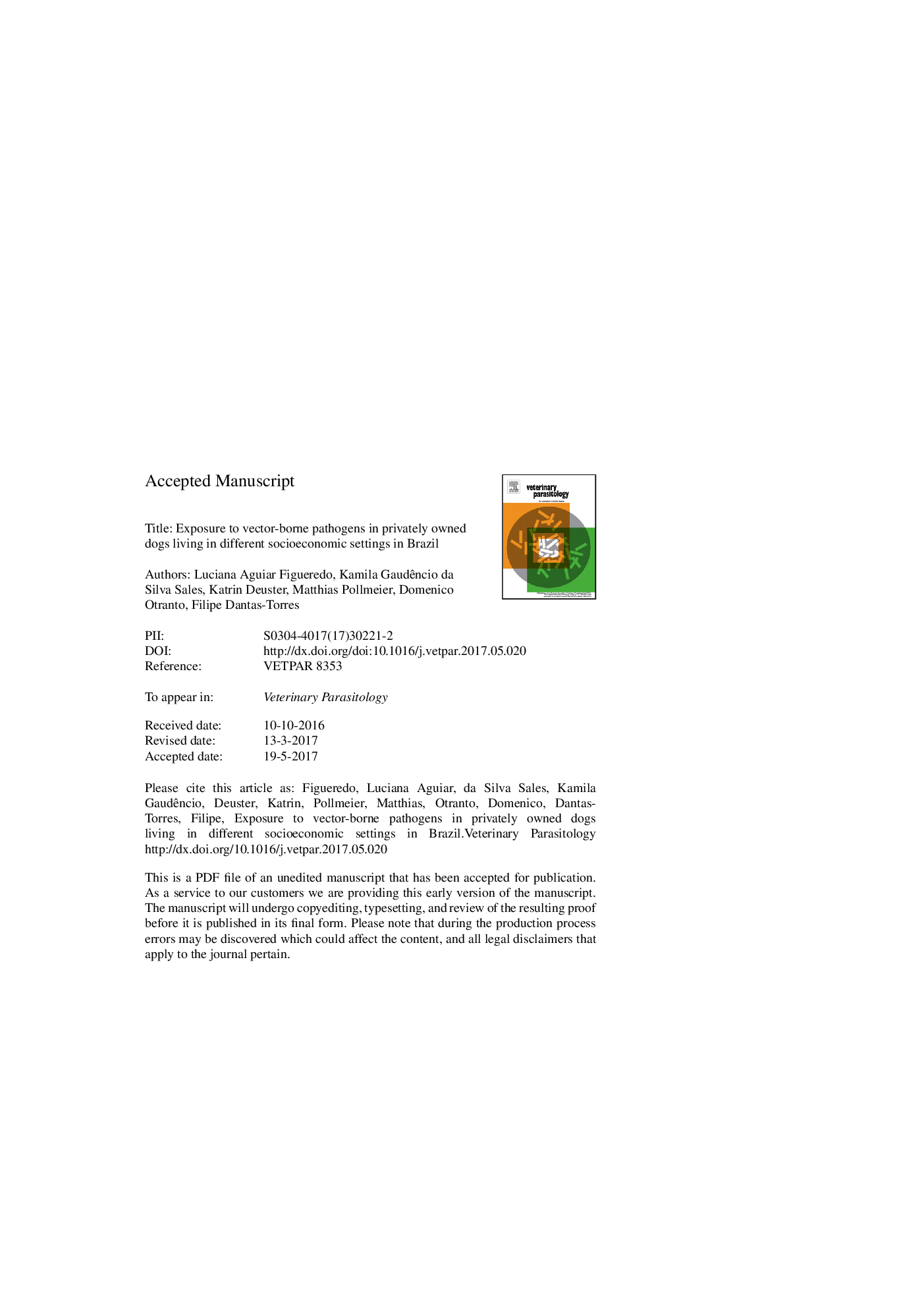| کد مقاله | کد نشریه | سال انتشار | مقاله انگلیسی | نسخه تمام متن |
|---|---|---|---|---|
| 5545581 | 1555633 | 2017 | 24 صفحه PDF | دانلود رایگان |
عنوان انگلیسی مقاله ISI
Exposure to vector-borne pathogens in privately owned dogs living in different socioeconomic settings in Brazil
ترجمه فارسی عنوان
قرار گرفتن در معرض حملات پاتوژن های بردار در سگ های خصوصی که در محیط های مختلف اقتصادی و اجتماعی در برزیل زندگی می کنند
دانلود مقاله + سفارش ترجمه
دانلود مقاله ISI انگلیسی
رایگان برای ایرانیان
کلمات کلیدی
سگ ها، کیک، کرفس، بیماری های برونگرا،
موضوعات مرتبط
علوم زیستی و بیوفناوری
علوم کشاورزی و بیولوژیک
علوم دامی و جانورشناسی
چکیده انگلیسی
This survey was conducted in four Brazilian cities, from three federative units (Pernambuco, Minas Gerais, and Federal District), representing different socioeconomic settings, to determine the presence of antibodies to or antigens and DNA of selected pathogens in privately owned dogs. From January to April 2015, blood and serum samples were collected and assayed using different tests. In particular, antibodies to Anaplasma spp., Borrelia burgdorferi sensu lato, and Ehrlichia spp., and antigens of Dirofilaria immitis were detected using a rapid enzyme-linked immunosorbent assay, whereas antibodies to Babesia spp. were detected by an immunofluorescence antibody assay. Moreover, the presence of Leishmania DNA in blood samples was assessed by real-time polymerase chain reaction. Overall, 208 (69.3%) out of 300 dogs were positive for at least one tested pathogen (intended here as antibodies, antigen or DNA, as abovementioned), with 139 (66.8%) of them being positive to two or more pathogens. No dog presented antibodies to B. burgdorferi s.l., and D. immitis antigens were detected exclusively in dogs from Pernambuco. Among positive dogs, the most common clinical signs were lymphadenomegaly (45.2%), onychogryphosis (41.3%), dermatitis (34.1%), pale mucous membranes (19.7%), weight loss (14.9%), fever (12.5%), alopecia (11.1%), and lethargy (4.8%). Tick and flea infestations were recorded in 41.7% and 29.3% of the dogs, respectively, with 49 (16.3%) dogs being co-infested by both ticks and fleas. Most of the tick- and flea-infested dogs presented high level of infestation (>10 ticks and >20 fleas). The level of tick infestation varied significantly among federative units, being highest in Minas Gerais (68.0%), followed by Pernambuco (36.0%) and Federal District (21.0%). On the other hand, the level of flea infestation was higher in Pernambuco (50.0%), followed by Minas Gerais (29.0%) and Federal District (9.0%). The number of dog owners reporting the use of ectoparasiticides (on dogs and/or in the environment) varied significantly, ranging from 6.0% in Pernambuco to 60.0% in Federal District. This study reveals disparate results in terms of dog exposure to fleas and ticks in the studied communities, which may be related to factors such as the owners' capability/willingness to afford the use of ectoparasiticides on their dogs and the dog's level of restriction. Further research is needed to establish the relationship between dog owners' socioeconomic situation and the level of exposure to ectoparasites and their transmitted pathogens.
ناشر
Database: Elsevier - ScienceDirect (ساینس دایرکت)
Journal: Veterinary Parasitology - Volume 243, 30 August 2017, Pages 18-23
Journal: Veterinary Parasitology - Volume 243, 30 August 2017, Pages 18-23
نویسندگان
Luciana Aguiar Figueredo, Kamila Gaudêncio da Silva Sales, Katrin Deuster, Matthias Pollmeier, Domenico Otranto, Filipe Dantas-Torres,
